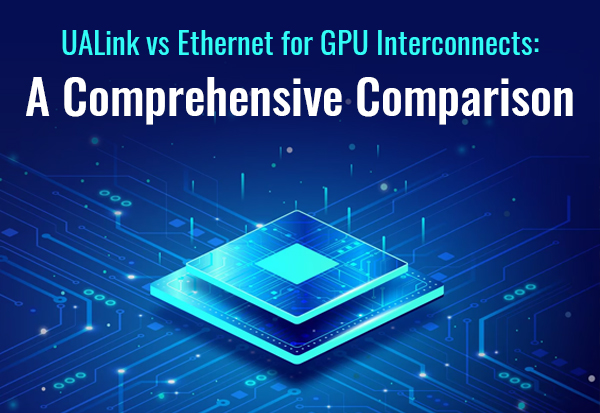UALink vs Ethernet-Based Solutions for GPU Interconnects: ADetailed Comparison
When building high-performance computing (HPC) or artificial intelligence (AI) clusters, choosing the right GPU interconnect technology is crucial. Two major options are emerging in the industry: UALink (Ultra Accelerator Link) and Ethernet-based solutions (such as RoCE—RDMA over Converged Ethernet). Each has its own strengths, weaknesses, and best use cases. This article provides an in-depth comparison to help you determine which solution best fits your needs.
Understanding UALink: The Future of GPU-to-GPU Communication
What is UALink?
UALink is a high-bandwidth, low-latency interconnect standard designed specifically for direct GPU-to-GPU communication. Developed as an open alternative to NVIDIA’s NVLink, UALink is backed by major industry players, including AMD, Intel, and other AI hardware companies. The goal of UALink is to enable high-speed, coherent memory sharing across multiple GPUs, improving efficiency for AI and workloads.
Key Features of UALink
● Ultra-high bandwidth: Expected to exceed NVLink 5.0’s 900GB/s bidirectional bandwidth, enabling ultra-fast GPU communication.
● Low-latency communication: Significantly lower than Ethernet, making it ideal for large-scale AI model training and real-time data processing.
● Scalability: Enables direct GPU fabric without requiring CPU involvement, improving parallelism and efficiency.
● Coherent memory access: GPUs can access each others memory without excessive data copying, optimizing large-scale deep learning models.
● Open standard: Reduces dependency on proprietary solutions like NVLink and fosters interoperability among multiple hardware vendors.
Best Use Cases for UALink
Given its strengths, UALink is particularly suited for environments that require rapid GPU-to-GPU communication:
● AI and ML training involving large models and fast communication between GPUs.
● HPC applications that require efficient parallel processing.
● Large-scale GPU clusters that demand direct memory sharing and low-latency synchronization.
Ethernet-Based Solutions: A Flexible and Scalable Alternative
What Are Ethernet-Based GPU Interconnects?
Ethernet-based solutions utilize standard networking protocols to interconnect GPUs. Enhanced with RDMA (Remote Direct MemoryAccess) technologies like RoCE (RDMA over Converged Ethernet), these solutions allow direct memory access between GPUs without CPU involvement.
Unlike UALink, which is specifically designed for GPU-to-GPU communication, Ethernet solutions are general-purpose, making them more suitable for heterogeneous computing environments where GPUs , CPUs, and storage need to interact seamlessly.
Key Features of Ethernet-Based GPU Solutions
● Standardization and availability: Leverages existing data center infrastructure, reducing deployment complexity.
● Scalability: Supports distributed GPU clusters across multiple data centers, making it suitable for cloud-based AI workloads.
● Flexibility: Works not just for GPU-to-GPU communication but also for CPU-GPU data exchanges and storage networking.
● RDMA support: Technologies like RoCE v2 improve performance by enabling direct GPU memory access, though latency is still higher than UALink.
Limitations of Ethernet for GPU Clusters
● Higher latency: Even with RDMA, latency remains in the microsecond range, compared to nanosecond-level latencies of UALink.
● Lower bandwidth: High-end Ethernet (e.g., 400GbE) provides around 50 GB/s per direction, far lower than UALink’s hundredsof GB/s.
● Lack of native memory coherence: GPUs must manually copy data rather than directly accessing remote memory.
Best Use Cases for Ethernet-Based Solutions
Ethernet-based interconnects are well-suited for:
● Distributed AI inference, where GPU-to-GPU communication is less frequent compared to training.
● Cloud-based AI workloads, where GPUs are spread across multiple data centers.
● General-purpose data center networking, where GPUs, CPUs ,and storage need seamless interaction.
Direct Comparison: UALink vs Ethernet-Based Solutions
Final Thoughts: Which One Should You Choose?
The choice between UALink and Ethernet-based solutions depends on your specific workload and infrastructure needs:
● If you require high bandwidth and ultra-low latency GPU-to-GPU communication, UALink is the superior choice. It is ideal for AI model training and HPC applications that depend on fast GPU interconnects.
● If you need a flexible, scalable solution for cloud-based AI workloads Ethernet-based solutions offer better interoperability with existing infrastructure and are better suited for distributed training and inference.
As UALink gains traction, it may become the dominant force in high-performance AI computing, while Ethernet will continue to power general-purpose and cloud-based AI infrastructures.
Would you like to explore deployment strategies for these interconnects? Let’s discuss in the comments below!
Explore More: Transformative Trends in the Semiconductor Industry: Redefining Technology for 2025




